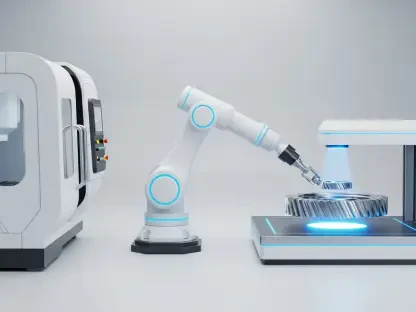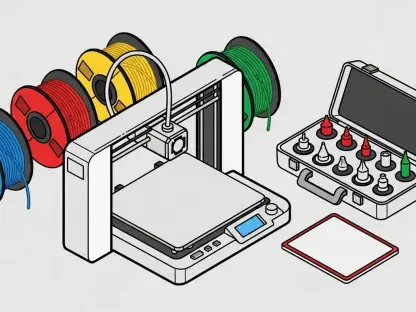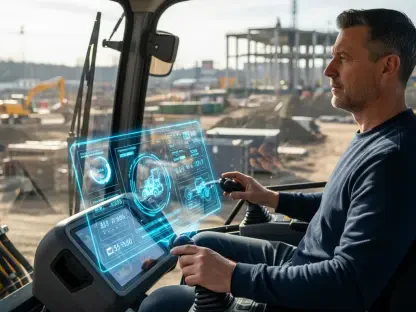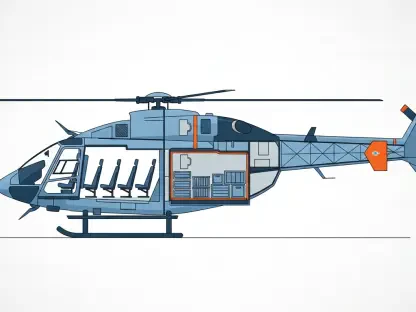Kwame Zaire, a manufacturing expert with a focus on electronics, equipment, production management, predictive maintenance, quality, and safety, brings a wealth of knowledge to aircraft interior design. With a deep understanding of both the technical and aesthetic aspects of the manufacturing process, Kwame has insights that are reshaping how we think about aircraft interiors.
What are the current trends in commercial aircraft interior design?
Current trends are heavily influenced by sustainability, technology, and hospitality-driven approaches. The industry is prioritizing lightweight, eco-friendly materials, taking cues from circular design principles. Technology is enhancing passenger experiences through immersive entertainment and interactive digital layers. Hospitality-driven design emphasizes cultural narratives and warm, inviting environments. Lastly, space optimization is key, focusing on maximizing passenger wellbeing by efficiently using available cabin space.
Can you elaborate on the trend of sustainability and circular design in aircraft interior design?
Sustainability is crucial in contemporary aircraft design. Airlines are now opting for materials that are not only lightweight but also bio-based and flame-retardant, lowering CO₂ emissions significantly. Circular design principles involve using regenerative materials that can be recycled or repurposed at the end of their lifecycle. This reduces environmental impact and supports a sustainable aviation industry.
How are airlines incorporating technology to enhance passenger experiences?
Technology is redefining passenger experiences in aircraft cabins. From interactive screens offering immersive entertainment to smart seats that adjust for optimum comfort, technological advancements cater to passengers’ varied needs. Features such as enhanced connectivity and personalized amenities are becoming standard, allowing passengers to use their flight time more efficiently and enjoyably.
How does hospitality-driven design change the passenger experience in commercial aircraft?
Hospitality-driven design transforms the passenger experience by creating a sense of home in the air. Airlines are moving away from generic corporate branding to embrace local cultural narratives, using color palettes and materials that evoke warmth and comfort. This approach fosters a welcoming atmosphere, enhancing passenger satisfaction and brand loyalty.
How is space optimization impacting passenger wellbeing in aircraft cabins?
Optimizing space is crucial for passenger wellbeing. First-class passengers typically receive more space, but strategic design can improve comfort for all cabin classes. Efficient use of space ensures that passengers enjoy adequate legroom, personal storage, and privacy, whether they are dining, working, or sleeping. Innovative layouts and ergonomic designs contribute to a more comfortable and enjoyable flight experience.
How does designing aircraft passenger experiences differ from designing for automotive or other settings?
Designing for aircraft is distinct due to the extended duration of flights and the public nature of cabin environments. Unlike cars, aircraft interiors need to accommodate multiple activities like dining, working, and sleeping while ensuring passenger privacy and comfort over long periods. Aircraft designs must also be durable and timeless, given their long lifecycle compared to automotive interiors that can evolve more rapidly.
What unique challenges come with designing for aircraft compared to automobiles?
Aircraft design confronts unique challenges such as space constraints, material regulations, and the need for multi-functional seating. Seats must be comfortable for long periods, provide sufficient privacy, and support various passenger activities. Additionally, aircraft interiors have stringent safety standards and require materials that are lightweight yet durable.
How do aircraft interiors accommodate different activities like dining, working, and sleeping?
Aircraft interiors are designed to be versatile spaces. Seats can transform from dining to working to sleeping modes, offering passengers flexibility. Features like adjustable lighting, ergonomic seating, and compact storage ensure that passengers can comfortably switch between activities, all while maintaining privacy and maximizing their comfort.
How do you define passenger needs and wants, especially when they may not be able to articulate them?
Passenger needs are often identified through human-centered research, which involves observing behaviors, pain points, and preferences. Surveys, focus groups, and immersive studies can reveal insights into what passengers value most, even if they can’t explicitly express it. This data guides the design process to create intuitive and satisfying cabin experiences.
What specific research methods do you use to identify passenger behaviors and pain points?
We employ a range of methods, including direct observation, user journey mapping, and feedback collection through surveys and focus groups. Advanced tools like biometric sensing can also help understand passenger comfort levels in real-time, allowing us to develop designs that address specific pain points and enhance overall satisfaction.
Can you provide a specific example of how passenger insights have influenced your design strategies?
For example, feedback on seat comfort and privacy has led to the development of adjustable headrests and side panels in economy class. Passengers expressed a need for more personal space and better sleep support, prompting us to integrate features that not only improve comfort but also provide a more private experience, even in a crowded cabin.
How do you ensure that the airline’s branding and unique selling proposition are reflected in the design?
We ensure that each airline’s DNA is embedded in the design through a careful study of their brand values. Elements like regional influences, preferred color schemes, and unique service philosophies are woven into the cabin environment. This thoughtful integration helps reinforce brand identity while enhancing passenger loyalty.
How do you incorporate an airline’s DNA into the design of their aircraft interiors?
Incorporating an airline’s DNA starts with understanding their brand narrative and passenger demographics. We translate this understanding into tangible elements like seat design, lighting, and material choices that reflect their core values. Whether it’s through cultural references or distinct color palettes, these elements ensure that passengers have a uniquely branded experience.
Can you provide an example of a project where airline branding played a significant role in the design?
For example, STARLUX Airlines’ cabin design incorporated Taiwanese cultural elements and hospitality standards. We used seasonally inspired lighting and regional materials to create an atmosphere that feels both luxurious and familiar, enhancing passenger satisfaction and reinforcing the airline’s brand identity.
At what stage do you interact with the airplane manufacturers and equipment suppliers as well as airlines?
We engage with stakeholders from the very beginning of the design process to ensure alignment on the vision and regulatory requirements. Early collaboration with airline partners allows us to incorporate emerging technologies and safety standards. We also coordinate with equipment suppliers to integrate innovative materials and design solutions seamlessly.
How do you collaborate with airline partners in the early stages of the design process?
Collaboration with airline partners begins right from the initial concept phase. We hold workshops and brainstorming sessions to understand their vision and requirements. This continuous interaction ensures that the design aligns with their goals and incorporates the latest technological and safety innovations.
What role do equipment suppliers play in integrating the latest innovations in aircraft design?
Equipment suppliers are crucial for integrating cutting-edge innovations. They provide expertise in materials, connectivity solutions, and structural design. By collaborating closely with these suppliers, we can push the boundaries of aircraft interior design while ensuring compliance with aviation standards and feasibility for production.
Do you work with seating designers to create custom solutions, or do you rely on seating manufacturers and others to generate the product features that you later choose to incorporate?
We take a combined approach, collaborating with seat manufacturers while also developing custom solutions. For highly unique airline experiences, we tailor seating designs to specific brand needs. For broader use, we create adaptable seating platforms that can be personalized through various material and aesthetic choices.
Can you describe your approach to working with seat manufacturers for differentiated airline experiences?
For differentiated experiences, we co-create designs with seat manufacturers, focusing on unique features that align with specific airline themes. This holistic approach ensures that the seating not only meets practical requirements but also resonates with the airline’s brand identity and passenger expectations.
How do you develop seating platforms that multiple airlines can adopt?
We develop versatile seating platforms by focusing on modular designs that can be easily customized. Features such as adjustable comfort settings and interchangeable components allow multiple airlines to adopt these seats while personalizing them through choices in fabrics, colors, and additional functionalities.
How do your passenger considerations change when designing for business class vs. economy or economy plus?
Designing for different classes involves prioritizing distinct elements. Business class emphasizes privacy and premium services, economy plus focuses on enhanced space and amenities, while economy class balances efficiency and comfort. Each class demands a tailored approach to ensure that passengers receive the best possible experience for their fare.
What specific design elements are prioritized in business class?
Business class prioritizes elements such as privacy, premium seating, and enhanced service. Features like lie-flat seats, personal spaces for working, and high-end materials contribute to an environment where passengers can comfortably work, relax, or sleep throughout their journey.
How does your design approach differ for economy plus?
Economy plus design focuses on providing enhanced legroom and amenities without the premium cost of business class. Improved ergonomic seating, additional storage options, and minor luxury elements like better cushioning and adjustable headrests are prioritized to offer a more comfortable experience than standard economy.
What strategies do you use to optimize the economy class experience?
To optimize economy class, we implement strategies such as ergonomic seating, efficient layout design, and smart storage solutions. Innovations in materials and seat function, like slimmer seats with improved lumbar support, help maximize comfort without sacrificing space.
How do you manage seat pitch expectations between airlines and passengers?
We manage seat pitch expectations by balancing legroom with overall cabin design. Staggered seating layouts, innovative storage, and ergonomic advancements can increase perceived space, allowing passengers to feel more comfortable without airlines having to increase pitch substantially.
What innovative solutions do you use to enhance legroom?
Innovative solutions include staggered seating, which offsets seats to create more legroom; slimline seats that reduce bulk without compromising comfort; and smart storage options under seats that free up space for stretching out. These designs ensure passengers can enjoy more legroom without extensive reconfiguration.
What is your forecast for the future of aircraft interior design?
I envision the future of aircraft interior design being dominated by enhanced personalization, sustainability, and technological integration. Passengers will increasingly expect custom-tailored experiences facilitated by smart technologies and eco-friendly materials. Airlines that embrace these trends will set new standards for comfort and efficiency in air travel.









